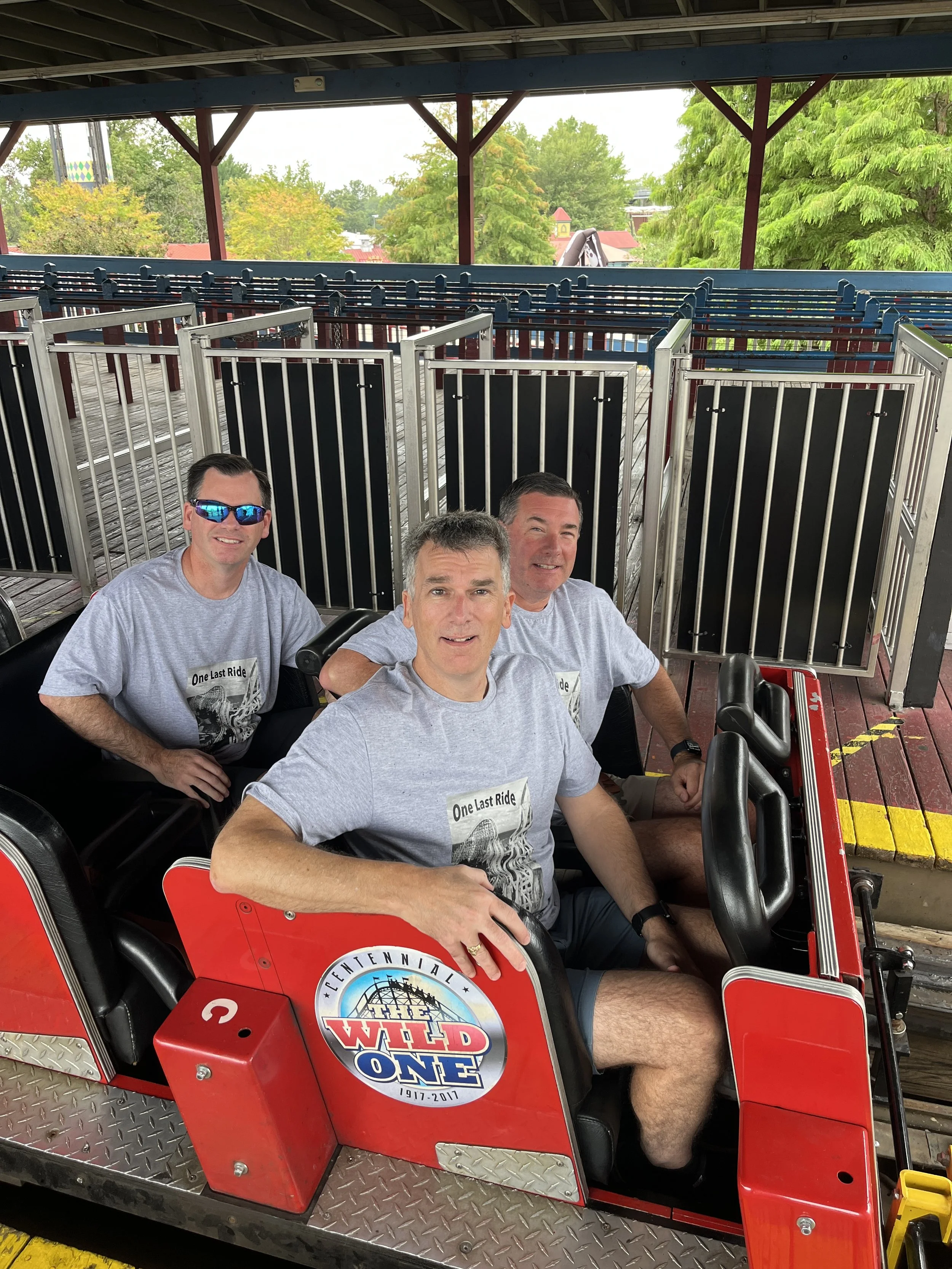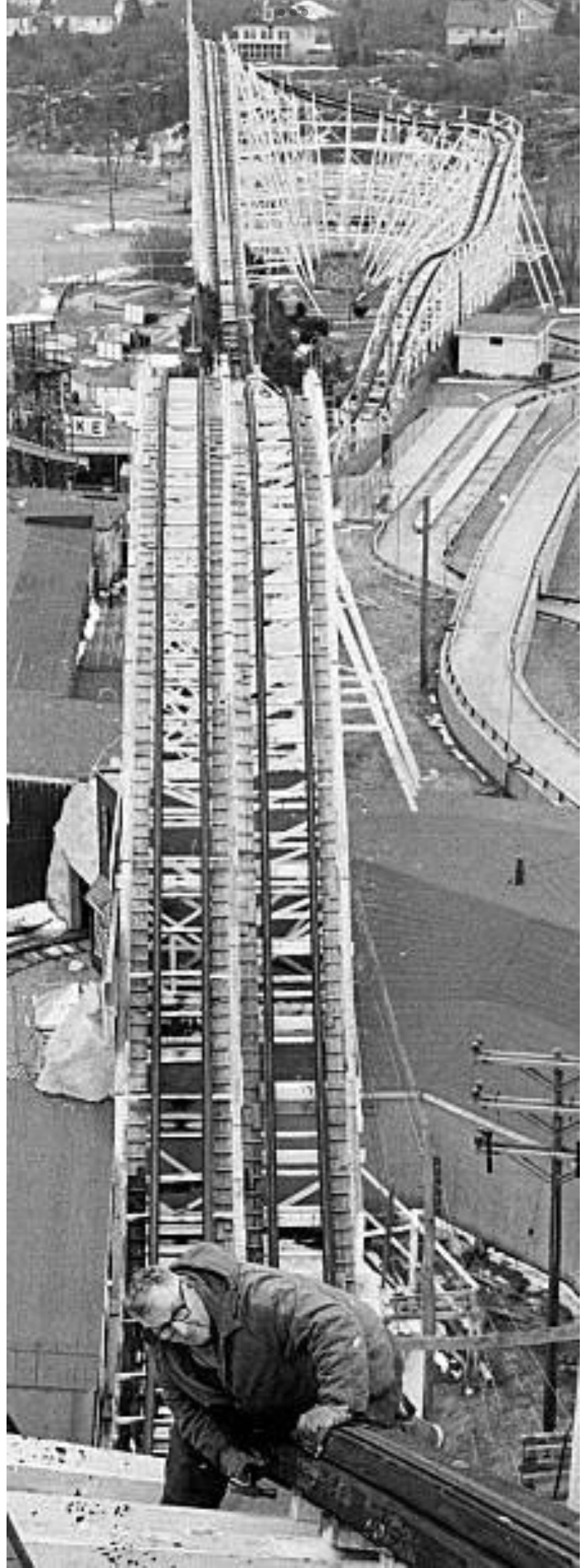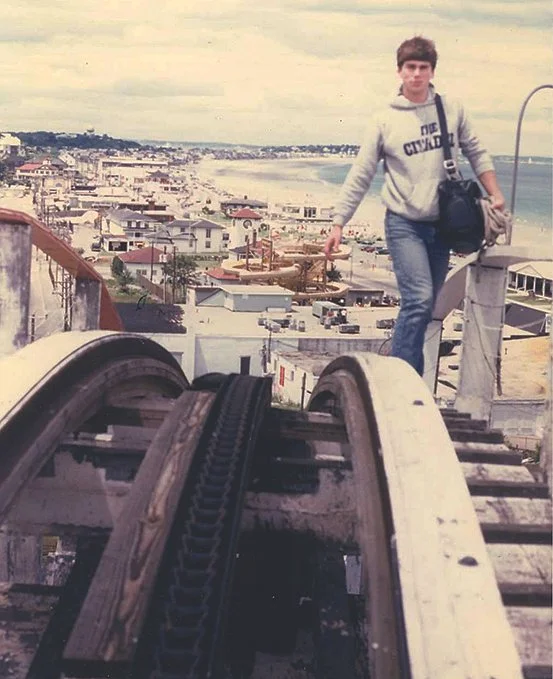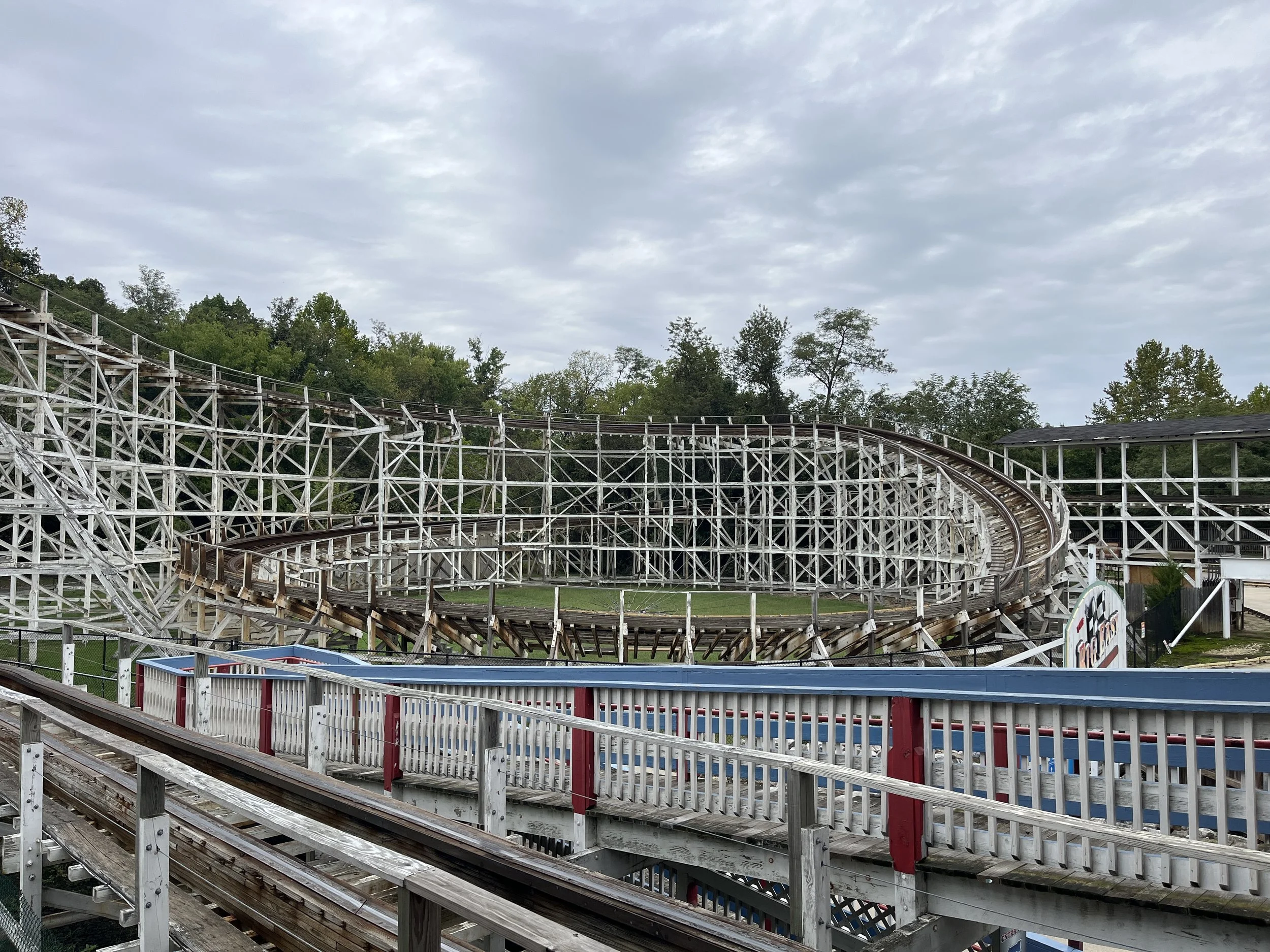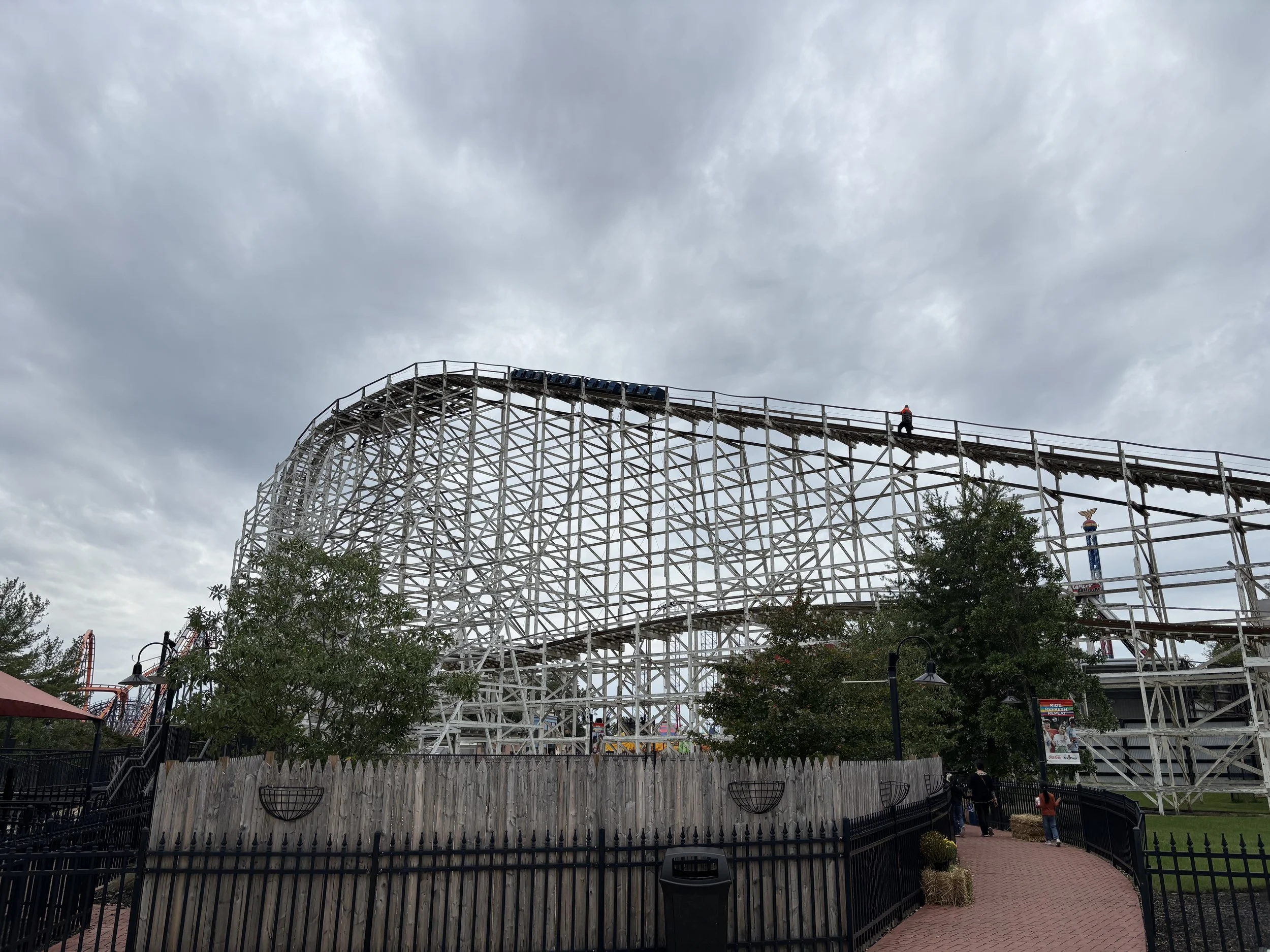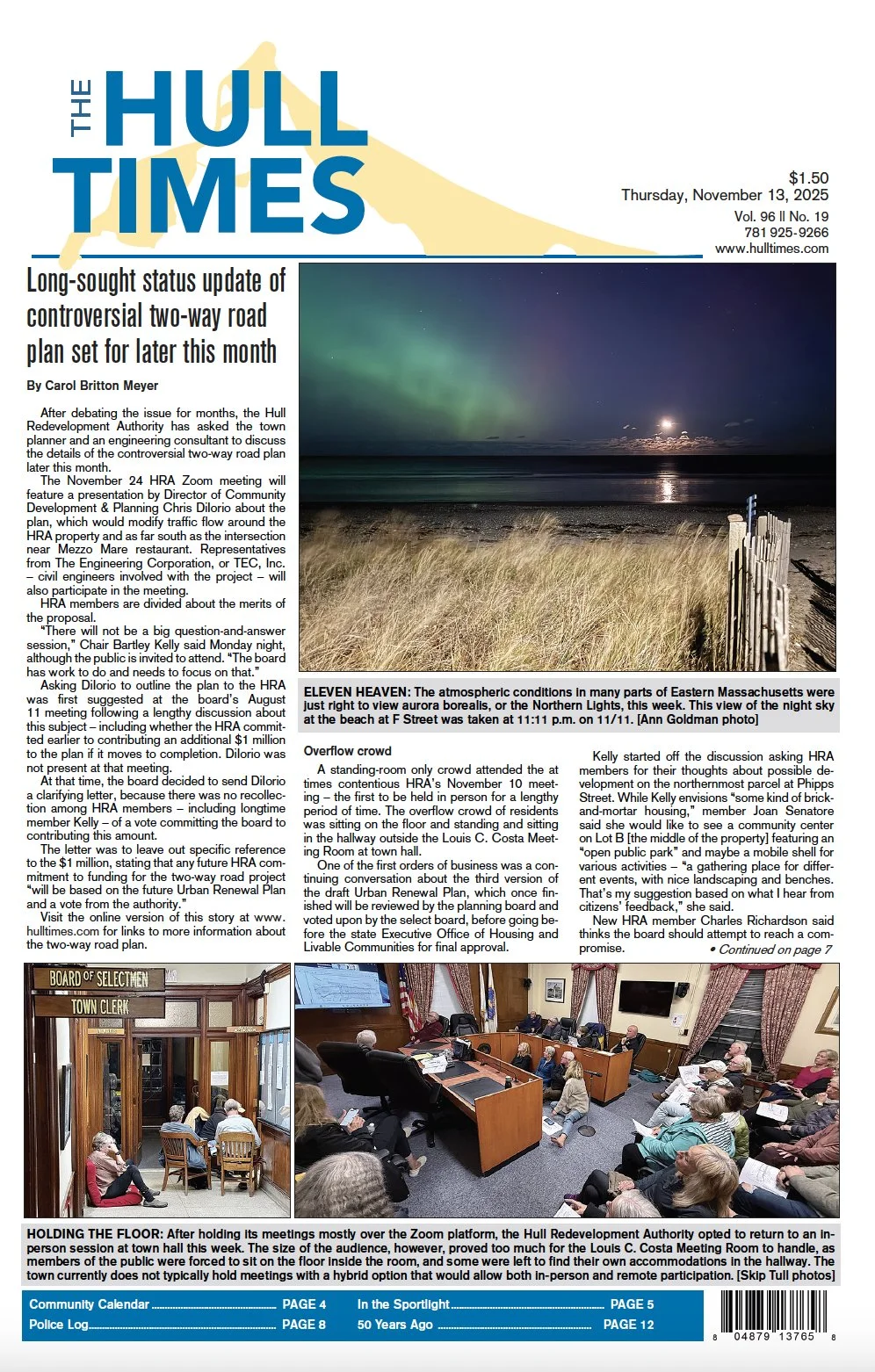Locals make the pilgrimage to Maryland for ‘one last ride’ on Paragon’s old roller coaster
/Essay by Christopher Haraden
On the rainy afternoon of June 12, 1985, I clearly remember looking up at Paragon Park’s Giant Coaster as it was auctioned off to the highest bidder, believing it would be one of the last times I’d ever see it standing.
Fast-forward a full 40 years later to the misty afternoon of September 27, 2025, when I once again looked up at the roller coaster’s 98-foot-tall first hill – this time in its “new” location at Six Flags America in Bowie, Maryland – once again believing it would be the last time I’d ever see it standing.
The serendipity of those two events, four decades and 450 miles apart, highlights the magic of Paragon nostalgia that defines the childhood of generations of Hull kids – enough to prompt three of them to plan a road trip to ride the roller coaster again before Six Flags closes for good at the end of this season.
THE LAST RIDE: Three Hull ‘kids’ made the pilgrimage to Six Flags America in Maryland to ride the former Paragon Park roller coaster before the park closes for good – from left, Sean McGowan, Chris Haraden, and Jim McGowan.
Last weekend, that’s exactly what three of us did.
Wearing custom-made T-shirts promoting our “One Last Ride” pilgrimage, longtime friends (and brothers) Jim McGowan, Sean McGowan, and I achieved our goal on Saturday and made some new memories in the process. The trip was extra-special for me, as my grandfather, Frank Infusino, worked as part of the roller coaster’s maintenance crew for decades. Growing up in the Rockaway neighborhood behind the park, the sound of the coaster’s daily operation was the soundtrack of our summers. And just before the wooden structure was taken down, I had the chance to walk the track to photograph its place in history, retracing the steps my grandfather had taken so many times over the years.
ON TRACK: The author’s grandfather, Frank Infusino, worked on the roller coaster for decades as an employee of Paragon Park.
But first, some background.
Paragon Park opened at Nantasket Beach in 1905 and always had a roller coaster in some form, although changes resulting from a series of fires in the early 1900s dramatically altered the park’s landscape. After a devastating fire in 1916, owner George A. Dodge commissioned the construction of what he called the Giant, a 98-foot-tall wooden roller coaster that dwarfed any previous ride at Nantasket Beach in both height and distance.
At the time it opened in 1917, it was the tallest roller coaster in the world.
Paragon Park and its Giant Coaster survived the Roaring’20s, the Great Depression, World War II, the opening of Disneyland and Disney World, and the rising popularity of automobiles and airplanes as modes of travel – meaning that families no longer were limited to vacation destinations near their homes. As one amusement operator observed, the same methods of transportation that helped bring people to the beach resorts now could bring them to places even farther away.
The park’s roller coaster changed along with the times. Its first drop was made steeper and the speed of the ride increased as park patrons began to look for more thrilling rides. A significant fire in 1963 changed the Giant’s design, as it burned the rear section known as the “helix” that brought riders around a double-level circular track that shook them up one final time before heading back to the loading station. Time and cost considerations meant that the rebuilding of the ride in the fire’s aftermath left out this section, and the layout of the Giant Coaster that reopened later in 1963 is the one most of us remember riding right up until Paragon’s last season.
As Paragon lumbered along, relatively little changed during the next two decades except the names and locations of some of the rides. Every few years, rumors would circulate that Paragon was for sale and that the owners would retire. But then each spring, the gates would swing open to welcome another season of visitors from all over New England.
Until they didn’t.
By 1984, the Massachusetts real estate market was blossoming, and the factors that in the past had limited Paragon’s ability to expand now gave it extra value – it was sandwiched between two bodies of water and the views that came with them. A developer made the owners an offer they couldn’t refuse, and as the new year dawned in January, an announcement was made that the 1985 season would be the park’s last. Within weeks, however, the sale was rescheduled to springtime, as the owners decided that there were too many risks from souvenir-seekers, litigious loiterers, and potential vandals.
Without even knowing it, we’d had our last ride at Paragon Park.
At the June auction, the most visible prize didn’t attract the highest bid, but garnered the most attention. Wild World amusement park near Baltimore – which later became Six Flags America – paid $28,000 to buy the Giant, and promptly announced plans to dismantle the ride piece-by-piece and have it rebuilt in time for the next season.
Incredibly, Paragon’s Giant had a new lease on life.
VIEW FROM THE TOP: Times Editor Chris Haraden climbed the roller coaster as part of a photography project prior to its dismantling in 1985.
As the crews arrived to start disassembling the ride, another quirk of fate presented me with a once-in-a-lifetime opportunity. The photographer hired to chronicle the coaster’s last days in Hull needed someone to carry his camera equipment and asked me to come along. I put aside my fear of heights and spent a day walking the track, just as my grandfather had done all those years before.
The Maryland park found the old blueprints and rebuilt the section that burned in 1963, so the coaster as it exists is slightly different from what many remember at Paragon. The park renamed the ride the Wild One and opened it on May 3, 1986. Like it did at Nantasket, the roller coaster survived changing economic conditions, world events, and changes in the park around it. Eventually, the Six Flags chain bought the park, and in May of this year, announced it was closing. No mention was made then – or since – of what will happen to the rides and attractions once the park closes for the last time on November 2.
A GOOD TURN: This section of the roller coaster, known as the ‘helix,’ was destroyed by fire at Paragon Park in 1963. It was rebuilt when the ride was moved to Maryland.
It was against this backdrop that the three of us decided to make the trip to Maryland for “one last ride.”
The Wild One has seen better days – similar to how it appeared in its final years at Paragon – and Six Flags America itself was bathed in a melancholy air. The late-season attendance was sparse and there were no lines at the rides, games, or food stands. The sight of the three of us wearing identical shirts with a picture of the roller coaster attracted some attention, both from employees and from other patrons. One of the ride operators told us they’d encountered others from this area who had made a similar nostalgic trip in recent months.
Whether caused by the occasional rain showers, lack of maintenance, or the ghosts of Paragon Park, the roller coaster had one final surprise for us. After a few rides, the three of us explored the remainder of Six Flags and then returned to the Wild One for our true “last ride,” only to find that one of the trains was stuck about three-quarters of the way up the lift hill. A park employee had to climb up and give it a push. While this happened often at Paragon without interrupting the operation of the ride, the crew at Six Flags was more cautious and closed it for the afternoon.
Once again, without even knowing it, we’d had our last ride.
SLOW RIDE: On Saturday, one of the roller coaster’s trains became stuck on the first hill. A park employee can be seen climbing up to push it over the top.
While watching this unfold, we met some members of the American Coaster Enthusiasts, who said the group had heard of plans to try to save the Giant – I mean, the Wild One – but there was nothing concrete to report. The probability of it being saved from the wrecking ball a second time is remote, but not out of the question. After all, we didn’t think it was possible 40 years ago, either.
That’s the great thing about amusement parks – there’s always the chance for something wonderful to happen.
Times Editor Christopher Haraden is a member of the Hull Historical Society and is compiling a history book about Paragon Park. For more information, visit www.paragonparkbook.com.
Like what you’re reading? Stay informed and support our work with a Hull Times subscription by clicking here.
Do you have an opinion to share? Click here to write a Letter to the Editor.
© 2025 The Hull Times. All rights reserved.


